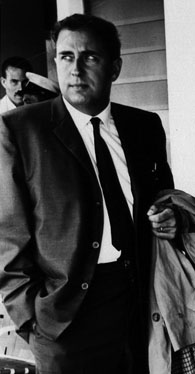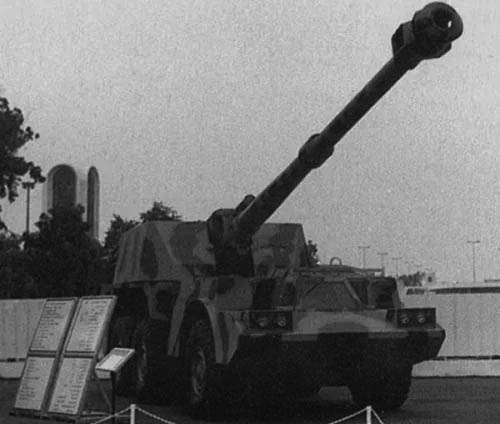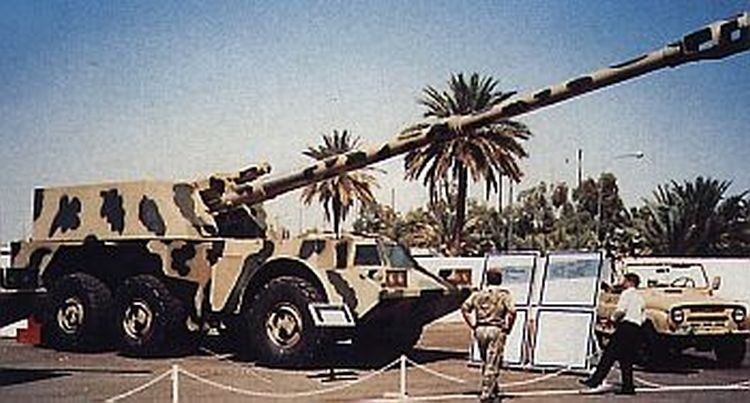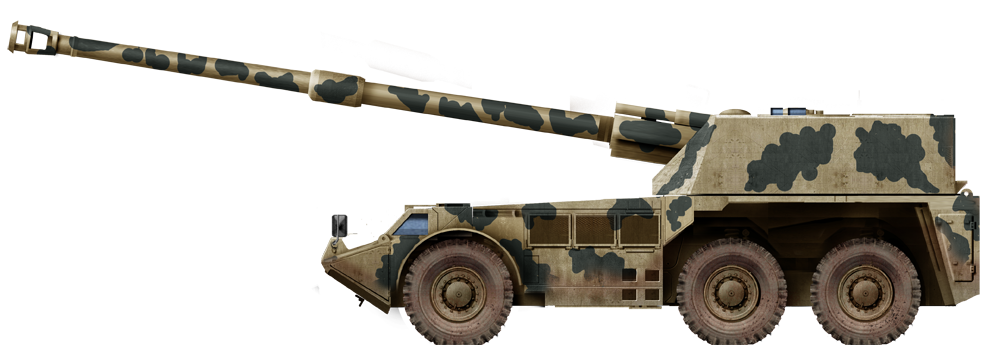Bull's monster self propelled gun: The Al Fao or Al Faw depending of arabic transliteration, is a large 210 mm self-propelled gun, 6x6, first displayed in Baghdad in 1989. Still foggy, it was clearly identified by experts as a South African G6 variant. It was one of the two vehicles developed by Canadian inventor gerald Bull, as well as the Al Majnoon, and the "supergun", far more mediatic.
 Canadian weapons engineer Gerald Vincent Bull (1928-1990) is a controversial figure, which assassination in Brussels in 1990 is movie stuff (HBO made one). As a student he worked in 1948 at the Institute of Aerodynamics (now the Institute for Aerospace Studies), creating a supersonic wind tunnel for the RCAF. He then worked at the Canadian Armament and Research Development Establishment, or CARDE, researching supersonic flight and a variety of rocket and missile projects in 1950-51, earning his PhD. In 1955 he made headlines in Canada by creating a wind tunnel capable capable of speeds up to Mach 4 at just $6,000. He worked on the Velvet Glove program, on smoothbore high-velocity guns, and sabots for increasing performance.
Canadian weapons engineer Gerald Vincent Bull (1928-1990) is a controversial figure, which assassination in Brussels in 1990 is movie stuff (HBO made one). As a student he worked in 1948 at the Institute of Aerodynamics (now the Institute for Aerospace Studies), creating a supersonic wind tunnel for the RCAF. He then worked at the Canadian Armament and Research Development Establishment, or CARDE, researching supersonic flight and a variety of rocket and missile projects in 1950-51, earning his PhD. In 1955 he made headlines in Canada by creating a wind tunnel capable capable of speeds up to Mach 4 at just $6,000. He worked on the Velvet Glove program, on smoothbore high-velocity guns, and sabots for increasing performance.
In 1956 his work at CARDE was remarked by Lieutenant General Arthur Trudeau (director of US Army Research and Development), which, impressed setup a similar facility afterwards at the Aberdeen Proving Ground. Under Dr. Charles Murphy, they later setup in 1961 a 5-inch (130 mm) gun for fire tests over the Atlantic at very long ranges. To study aerodynamics of gun missiles, Bull and Murphy started discussing the idea of firing scale aircraft models, and did test a variety of models, studying the supersonic schock cone. However defences policies in Canada saw the cancellation od the Avro Arrow on which he worked, and which angered him considerably.
Due to its tense relations with hierachy, Bull resigned from CARDE and started working on space tech, the High Altitude Research Program (Project HARP).He soon obtaining from the US Navy a surplus 16-inch battleship gun (later re-bored as smoothbore 16.4-in or 416 mm) for further projectiles tests. Tests started in 1962 with a dart-like finned projectile named Martlet. These projectiles were fired at 10,000 ft/s (3,048 m/s; 6,818 mph), reaching altitudes of 215,000 ft (66,000 m)... In 1963 with the Martlet 2 he approached the goal of a gun-launched rocket that could reach outer space. His final project setup for 1968 was the Martlet-4, a three-stage 16.4" rocket that would be fired from a lengthened gun at Barbados. But in 1967 a government change and general media attitude cancelled all fundings. Not deterred, Bull reinvested all his developed asset into a new company, Space Research Corporation (SRC), making himself an international artillery consultant.
Long story short, Bull developed several weapons systems over the years, notably the GC-45 howitzer produced in Sweden, and sold 50k ERFB shells to Israel in 1973 for their US supplied howitzers. Thanks to this, IDF M107s were able to fire these at 50 km, unmatched at the time. Due to his contribution to US artillery he got his US citizenship by an Act of Congress, a rare occurence. He also sold the GC-45 howitzer to Armscor of Pretoria, South Africa, used in the 1980s war against Angola, as the G5 howitzer, a 6x6 self-powered and towed heavy artillery piece. Under the Carter administration however, Bull was arrested for illegal arms dealing in violation of the UN arms embargo. After a 6 month sentence and, sued and fined $55,000 for arms dealing, he soon left Canada for Belgium. There, he created a subsidiary of SRC called European Poudreries Réunies de Belgique.
He continued working with the GC-45 design there, secured a contract with the PRC and Iraq, designing for the latter the 155 mm Al-Majnoonan, updated version of the G5, and after adapting the existing US 203 mm M110 howitzer, created the 210 mm Al-Fao capable of 56 km (35 mi) range without base bleed. Al-Majnoon were produced, unlike the latter, with additional barrels delivered from South Africa, built and sold through Austria. Due to its relations with Iraq he convinced the latter he could create a "supergun" for space launches which had Saddam Hussein interested, work starting on "Project Babylon", a 45-meter, 350 mm gun completed for testing and later started working on the real PC-2 (150 m long, 2,100 tonnes, 39 inches) for launching 2 tons payloads into orbit. Sections were made at Sheffield Forgemasters and Matrix Churchill, Spain, the Netherlands, and Switzerland to go around the UN embargo after the 1990 gulf war and sanctions. Gerald Bull however was shot by three men in March 1990 at his home and his company collapsed, soon perquisitioned, his gun's sections seized. Bull became quite a threat to Iran and Israel (with the latter being the most probable) but, CIA could have been involved as well, as MI5. The case was never officially elucidated. The Al-Fao is the logical pair to the Majnoon. Both were in appearance very close to the South African G6 Rhino self propeller howitzer. Development started on a real 1987 specification from the Iraqi Army, to out-range Iranian 175mm M107 self propelled howitzers (later the IDF was seen as a potential adversary and also had these). The vehicle needed to be wheeled, better adapted to the dry and flat conditiions of the Iraqi desert. It became the third attempt in the world (excluding the USSR) to create a wheeled artillery system on a SAU 6X6, with only comparisons being the 152mm Dana and South African 155mm G-6. Bull's office answered the specifications and proposed to the iraqi staff to built a 210mm self-propelled gun with unprecedented range, giving a clear superiority over the all Iranian artillery pieces to date, as war was still raging.
The Al-Fao is the logical pair to the Majnoon. Both were in appearance very close to the South African G6 Rhino self propeller howitzer. Development started on a real 1987 specification from the Iraqi Army, to out-range Iranian 175mm M107 self propelled howitzers (later the IDF was seen as a potential adversary and also had these). The vehicle needed to be wheeled, better adapted to the dry and flat conditiions of the Iraqi desert. It became the third attempt in the world (excluding the USSR) to create a wheeled artillery system on a SAU 6X6, with only comparisons being the 152mm Dana and South African 155mm G-6. Bull's office answered the specifications and proposed to the iraqi staff to built a 210mm self-propelled gun with unprecedented range, giving a clear superiority over the all Iranian artillery pieces to date, as war was still raging.
In this pre-1990 war stage, Iraq was still bankrolled and supported by the western world and Bull had no problem getting his project ahead. The development of the program was 1987 year. Spanish and French designers take part in the work on self-propelled artillery systems. In Spain Tribiland worked on the undercarriage and in France GIAT worked on the gun. Both were to be mated with a modified basis on which Bull worked already, the South African “Rhino” self-propelled artillery G6 freshly tested in combat against the Cubans on Angola.
Both howitzers have the same chassis with a central position driver, which seat wasmade according to South African ACS G6 with a sliding hatch and three armored windows. Next is located the engine compartment housing a large diesel engine from Mercedes-Benz, close to the HP 560 and completely isolated from the driver or turret, while in the back in installed the large slab-sided turret. On each side access hatches are cutout. Back of the turret tower is a shell ejector port and an ammunition hatch. At the bottom of the hull are two more hatches for turnover emergency exit. The chassis has essentally the same pneumatics as the G6, 21.00 XR25 tires with automatic pressure support system.
The main differences between the two vehicles was the artillery piece carried, 155mm 52 caliber for the Majnoon, compatible with Iraqi ammunitions, with automatic ejector, transversely slit muzzle brake, while the Al Fao's 210mm barrel is pretty unique, larger and longer and incompatible with any ammunitions but the ones produced by Bull's company. Both vehicle shares the same sight for direct fire located on the left side of the turret, next to the gun. Both are supposed to fire Bull's ERFB and ERFB-BB (assisted shells) for extra range derived from the ammunition used on the G-5 and GH N-45 towed artillery. The only known artillery piece that was not German pre-WWI or later, was the Czech 210 mm siege gun M1939 (Br-17).
Saddam's ace: Gerald "Bang for the Bucks" Bull
 Canadian weapons engineer Gerald Vincent Bull (1928-1990) is a controversial figure, which assassination in Brussels in 1990 is movie stuff (HBO made one). As a student he worked in 1948 at the Institute of Aerodynamics (now the Institute for Aerospace Studies), creating a supersonic wind tunnel for the RCAF. He then worked at the Canadian Armament and Research Development Establishment, or CARDE, researching supersonic flight and a variety of rocket and missile projects in 1950-51, earning his PhD. In 1955 he made headlines in Canada by creating a wind tunnel capable capable of speeds up to Mach 4 at just $6,000. He worked on the Velvet Glove program, on smoothbore high-velocity guns, and sabots for increasing performance.
Canadian weapons engineer Gerald Vincent Bull (1928-1990) is a controversial figure, which assassination in Brussels in 1990 is movie stuff (HBO made one). As a student he worked in 1948 at the Institute of Aerodynamics (now the Institute for Aerospace Studies), creating a supersonic wind tunnel for the RCAF. He then worked at the Canadian Armament and Research Development Establishment, or CARDE, researching supersonic flight and a variety of rocket and missile projects in 1950-51, earning his PhD. In 1955 he made headlines in Canada by creating a wind tunnel capable capable of speeds up to Mach 4 at just $6,000. He worked on the Velvet Glove program, on smoothbore high-velocity guns, and sabots for increasing performance.
In 1956 his work at CARDE was remarked by Lieutenant General Arthur Trudeau (director of US Army Research and Development), which, impressed setup a similar facility afterwards at the Aberdeen Proving Ground. Under Dr. Charles Murphy, they later setup in 1961 a 5-inch (130 mm) gun for fire tests over the Atlantic at very long ranges. To study aerodynamics of gun missiles, Bull and Murphy started discussing the idea of firing scale aircraft models, and did test a variety of models, studying the supersonic schock cone. However defences policies in Canada saw the cancellation od the Avro Arrow on which he worked, and which angered him considerably.
Due to its tense relations with hierachy, Bull resigned from CARDE and started working on space tech, the High Altitude Research Program (Project HARP).He soon obtaining from the US Navy a surplus 16-inch battleship gun (later re-bored as smoothbore 16.4-in or 416 mm) for further projectiles tests. Tests started in 1962 with a dart-like finned projectile named Martlet. These projectiles were fired at 10,000 ft/s (3,048 m/s; 6,818 mph), reaching altitudes of 215,000 ft (66,000 m)... In 1963 with the Martlet 2 he approached the goal of a gun-launched rocket that could reach outer space. His final project setup for 1968 was the Martlet-4, a three-stage 16.4" rocket that would be fired from a lengthened gun at Barbados. But in 1967 a government change and general media attitude cancelled all fundings. Not deterred, Bull reinvested all his developed asset into a new company, Space Research Corporation (SRC), making himself an international artillery consultant.
Long story short, Bull developed several weapons systems over the years, notably the GC-45 howitzer produced in Sweden, and sold 50k ERFB shells to Israel in 1973 for their US supplied howitzers. Thanks to this, IDF M107s were able to fire these at 50 km, unmatched at the time. Due to his contribution to US artillery he got his US citizenship by an Act of Congress, a rare occurence. He also sold the GC-45 howitzer to Armscor of Pretoria, South Africa, used in the 1980s war against Angola, as the G5 howitzer, a 6x6 self-powered and towed heavy artillery piece. Under the Carter administration however, Bull was arrested for illegal arms dealing in violation of the UN arms embargo. After a 6 month sentence and, sued and fined $55,000 for arms dealing, he soon left Canada for Belgium. There, he created a subsidiary of SRC called European Poudreries Réunies de Belgique.
He continued working with the GC-45 design there, secured a contract with the PRC and Iraq, designing for the latter the 155 mm Al-Majnoonan, updated version of the G5, and after adapting the existing US 203 mm M110 howitzer, created the 210 mm Al-Fao capable of 56 km (35 mi) range without base bleed. Al-Majnoon were produced, unlike the latter, with additional barrels delivered from South Africa, built and sold through Austria. Due to its relations with Iraq he convinced the latter he could create a "supergun" for space launches which had Saddam Hussein interested, work starting on "Project Babylon", a 45-meter, 350 mm gun completed for testing and later started working on the real PC-2 (150 m long, 2,100 tonnes, 39 inches) for launching 2 tons payloads into orbit. Sections were made at Sheffield Forgemasters and Matrix Churchill, Spain, the Netherlands, and Switzerland to go around the UN embargo after the 1990 gulf war and sanctions. Gerald Bull however was shot by three men in March 1990 at his home and his company collapsed, soon perquisitioned, his gun's sections seized. Bull became quite a threat to Iran and Israel (with the latter being the most probable) but, CIA could have been involved as well, as MI5. The case was never officially elucidated.
The vehicle: Al Fao (G7)
The Iran-Iraq war as starter
The design of the Majnoon and Al-Fao started at the same time, around 1988. South Africa tried to sell the G6 howitzer to Iraq, but the later found it too expensive, and requested two equivalents that could be manufactured in Iraq. Prototypes of each were to be ready by May 1989, just in tome for the Baghdad International Arms Fair. French, German and Spanish companies were contracted by Bull to manufacture parts while the chassis was bought in Czechoslovakia, modified to South African specifications. This was a very fast and feverish operation, and ultimately the deadline was met.Al Fao and Majnoon
 The Al-Fao is the logical pair to the Majnoon. Both were in appearance very close to the South African G6 Rhino self propeller howitzer. Development started on a real 1987 specification from the Iraqi Army, to out-range Iranian 175mm M107 self propelled howitzers (later the IDF was seen as a potential adversary and also had these). The vehicle needed to be wheeled, better adapted to the dry and flat conditiions of the Iraqi desert. It became the third attempt in the world (excluding the USSR) to create a wheeled artillery system on a SAU 6X6, with only comparisons being the 152mm Dana and South African 155mm G-6. Bull's office answered the specifications and proposed to the iraqi staff to built a 210mm self-propelled gun with unprecedented range, giving a clear superiority over the all Iranian artillery pieces to date, as war was still raging.
The Al-Fao is the logical pair to the Majnoon. Both were in appearance very close to the South African G6 Rhino self propeller howitzer. Development started on a real 1987 specification from the Iraqi Army, to out-range Iranian 175mm M107 self propelled howitzers (later the IDF was seen as a potential adversary and also had these). The vehicle needed to be wheeled, better adapted to the dry and flat conditiions of the Iraqi desert. It became the third attempt in the world (excluding the USSR) to create a wheeled artillery system on a SAU 6X6, with only comparisons being the 152mm Dana and South African 155mm G-6. Bull's office answered the specifications and proposed to the iraqi staff to built a 210mm self-propelled gun with unprecedented range, giving a clear superiority over the all Iranian artillery pieces to date, as war was still raging.
In this pre-1990 war stage, Iraq was still bankrolled and supported by the western world and Bull had no problem getting his project ahead. The development of the program was 1987 year. Spanish and French designers take part in the work on self-propelled artillery systems. In Spain Tribiland worked on the undercarriage and in France GIAT worked on the gun. Both were to be mated with a modified basis on which Bull worked already, the South African “Rhino” self-propelled artillery G6 freshly tested in combat against the Cubans on Angola.
Both howitzers have the same chassis with a central position driver, which seat wasmade according to South African ACS G6 with a sliding hatch and three armored windows. Next is located the engine compartment housing a large diesel engine from Mercedes-Benz, close to the HP 560 and completely isolated from the driver or turret, while in the back in installed the large slab-sided turret. On each side access hatches are cutout. Back of the turret tower is a shell ejector port and an ammunition hatch. At the bottom of the hull are two more hatches for turnover emergency exit. The chassis has essentally the same pneumatics as the G6, 21.00 XR25 tires with automatic pressure support system.
The main differences between the two vehicles was the artillery piece carried, 155mm 52 caliber for the Majnoon, compatible with Iraqi ammunitions, with automatic ejector, transversely slit muzzle brake, while the Al Fao's 210mm barrel is pretty unique, larger and longer and incompatible with any ammunitions but the ones produced by Bull's company. Both vehicle shares the same sight for direct fire located on the left side of the turret, next to the gun. Both are supposed to fire Bull's ERFB and ERFB-BB (assisted shells) for extra range derived from the ammunition used on the G-5 and GH N-45 towed artillery. The only known artillery piece that was not German pre-WWI or later, was the Czech 210 mm siege gun M1939 (Br-17).
Known technical features

The best known and unique one from the Baghdad military fair in 1989.
Bull started reworking the barrel, reboring the original 155 mm gun to a smoothbore 210 mm, longer barrel, reworked body to resist much higher pressure. It was "sold" to the iraqi as capable of a range of 56,000 metres (35 miles), well beyond the M107's reach. The Al-Fao as it was soon baptised by the Iraqi* after a symbolic location. However was a heavy vehicle, reaching 48 tons fully loaded in combat order. The Al-Fao weight are estimated close to 44 tonnes empty, with a 550 hp engine giving up to 60–70 km/h (37–43 mph) cross-country. The vehicle top speed was claimed to be about 72 km/h (44 mph) on road, with other sources claiming 90 kph, dubious due to the power to weight ratio. The range is unknown, probably less than the G6.
The main advantage of the gun is its autoloader, providing a rate of fire of four rounds a minute. Sources conflicts on the barrel, either rifled with 64 rings, or smoothbore. Its recoil id of 1,041 m in the rurret. Firing range estimated for the ERFB and ERFB-BB arerespectively 45 and 57.3 kilometer with a muzzle velocity of 990 meters/second. The final version of the gun was claimed to be able to fire four 109 kg (240 lb) rounds a minute. These shells has an utility payload and could be filled with chemicals like sarin, mustard or phosgene nut also regular high explosives. 8.3 in guns are rare on the market, and firing 109-kg shell over 57 km (35 mi) was at the time a record-setter for that class of vehicle. It has been beaten since.
*The weapon is named after the Al-Faw peninsula, southern Iraq in commemoration of heavy fighting in the Iran–Iraq War with difference in spelling due to differing transliterations of Arabic.
The gun was designed and built in Europe. none were captured during the 1991 Gulf War; the programme was probably cancelled thereafter. It was similar in design to the South African G6 howitzer, with which Bull was also involved as a designer, and appears to have been directly inspired by that system. Interestingly the Al-Fao, sometimes referred to as G7, was a wheeled mount. While G6 is already a big and heavy SP, Al-Fao is even bigger. To handle the howitzer's recoil, the wheeled platform was not robust enough, so a very large muzzle brake had to be fitted. The Al-Fao was one of two similar self-propelled howitzers developed by Bull for the Iraqis, the other being the Al-Majnoon 155 mm howitzer (sometimes transliterated as Al-Majnoon and based directly on the G5 howitzer, thus essentially a parallel development to the G6.
Fate
Both the Majnoon and Al-Fao were presented at the Arms Fair as planned in 1989, although far from complete. At least externally they looked the part. Bull was satisfied by the result, as well as iraqi officials. But it did not stopped there. By early 1990, before the invasion of kuwait, Iraq imported plans, equipment and machinery to produce the vehicles domestically, as well as ammunition, expecting to produce them in 1991 or 1992. However after the invasion, with parts still missing, the realisation of the Majnoon and Al-Fao projects into production fell to a standstill and was ultimately cancelled.The eventually production in a few vehicle of the Majnoon has been rumored for years, but no intel, before and during the invasion of Iraq, never attested these vehicles in any serie, there is no photo evidence, as well as of a possible assembly plant. Since Iraq has been cross-crossed by the coalition forces for decades, no evidence of the vehicles had been brought forward. The vehicles were either hidden or destroyed to avoid capture as no photo but those taken at the Baghdad fair ever surfaced. There was also a rumored capture in 1991, but again it remained unsubstantiated.

Iraqi Al Fao as displayed on the Baghdad arms exhibition, 1989.
Al Fao specifications | |
| Dimensions : | 15oa x 3.5 x 3.6 meters (barrel 11,13 m/53) |
| Total weight, battle ready | 43 light, 48 tons FL |
| Crew | 5 (commander, driver, gunner, loaders). |
| Propulsion | 550 hp Mercedes Diesel |
| Speed | 70-90 kph on flat estimated |
| Range/consumption | Unknown |
| Armament | Single 210 mm smoothbore howitzer, see notes. |
| Armor | Estimated same as G6 Howitzer 55°/40° angles |
| Ammunition used | |
| Total production | 1 Prototype |
Links
Altobchi, Ali; Cooper, Tom; Fontanellaz, Adrien (2022). Al-Hussein: Iraqi indigenous conventional arms projects, 1980-2003. Warwick, UK: Helion & Company Publishingreddit Photo
secretprojects.co.uk/
raigap.livejournal.com
About the G6 Rhino on TE
prom1.livejournal.com
en.topwar.ru
military-history.fandom.com
The Al Faw on Wikipedia FR

Modern Tanks
Modern MBTs posters

Denel Bagder (2018)

Type 16 MCV (2016)

Gepard 1A2 last rounds 2011

SANDF

Russian AFVs

Main Battle Tanks
